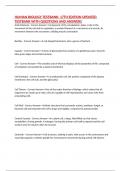HUMAN BIOLOGY TESTBANK- 17TH EDITION UPDATED
TESTBANK WITH QUESTIONS AND ANSWERS
Actin Filament - Correct Answer>>Component of the cytoskeleton; plays a role in the
movement of the cell and its organelles; a protein filament in a sarcomere of a muscle, its
movement shortens the sarcomere, yielding muscle contraction
Bacillus - Correct Answer>>A rod-shaped bacterium; also a genus of bacteria
Capsule - Correct Answer>>A form of glycocalyx that consists of a gelatinous layer; found in
blue-green algae and certain bacteria
Cell - Correct Answer>>The smallest unit of life that displays all the properties of life; composed
of cytoplasm surrounded by a plasma membrane
Cell Envelope - Correct Answer>>In a prokaryotic cell, the portion composed of the plasma
membrane, the cell wall, and the glycocalyx
Cell Theory - Correct Answer>>One of the major theories of biology, which states that all
organisms are made up of cells; cells are capable of self-reproduction and come only from
preexisting cells
Cell Wall - Correct Answer>>Cellular structure that surrounds a plant, protistan, fungal, or
bacterial cell and maintains the cell's shape and rigidity; composed of polysaccarides
Central Vacuole - Correct Answer>>In a plant cell, a large, fluid-filled sac that stores
metabolites. During growth, it enlarges, forcing the primary cell wall to expand and the cell
surface-area-to-volume ration to increase
Centriole - Correct Answer>>Cell structure, existing in pairs, that occurs in the centrosome and
may help organize a mitotic spindle for chromosome movement during animal cell division
,Centrosome - Correct Answer>>Central microtubule organized center of cells. In animal cells, it
contains two centrioles.
Chloroplats - Correct Answer>>Membrane-bounded organelle in algae and plants with
chlorophyll-containing membranous thylakoids; where photosynthesis takes place
Chromatin - Correct Answer>>Network of DNA strands and associated proteins observed within
a nucleus of a cell
Chromoplast - Correct Answer>>Plastid in land plants responsible for orange, yellow, and red
color of plants, including the autumn colors in leaves
Chromosome - Correct Answer>>The structure that transmits the genetic material form one
generation to the next; composed of condensed chromatin; each species has a particular
number of chromosomes that is passed on to the next generation
Cilia (Sing., Cilium) - Correct Answer>>Short, hairlike projections from the plasma membrane,
occurring usually in larger numbers
Cristae (Sing., Crista) - Correct Answer>>Short, finger-like projections formed by the folding of
the inner membrane of the mitochondira
Cynobacterium (Pl., Cyanobaceria) - Correct Answer>>Photosynthetic bacterium that contains
chlorophyll and releases oxygen; formerly called a blue-green alga
Cytoplasm - Correct Answer>>Region of a cell between the nucleus, or the nucleoid region of a
bacterium, and the plasma membrane; contains the organelles of the cell
Cytoskeleton - Correct Answer>>Internal framework of the cell, consisting of microtubules,
actin filaments, and intermediate filaments
, Endomembrane System - Correct Answer>>Cellular system that consists of the nuclear
envelope, endoplasmic reticulum, Golgi apparatus, and vesicles
Endoplasmic Reticulum (ER) - Correct Answer>>System of membranous saccules and channels
in the cytoplasm, often with attached ribosomes
Eukaryotic Cell (Eukaryote) - Correct Answer>>Type of cell that has a membrane-bounded
nucleus and membranous organelles; found in organisms with the domain Eukarya
Gene - Correct Answer>>Unit of heredity existing as alleles on the chromosomes; in diploid
organisms, typically to alleles are inherited-one from each parent
Glycocalyx - Correct Answer>>Gel-like coating outside the cell wall of a bacterium. If compact, it
is called a capsule; if diffused, it is called a slime layer
Golgi Apparatus - Correct Answer>>Organelle consisting of sacs and vesicles that processes,
packages, and distributes molecules about or from the cell
Granum (Pl., Grana) - Correct Answer>>Stack of chlorophyll-containing thylakoids in a
chloroplast
Intermediate Filament - Correct Answer>>Rope-like assemblies of fibrous polpypeptides in the
cytoskeleton that provide support and strength to cells; so called because they are
intermediate in size between actin filaments and microtubules
Lysosome - Correct Answer>>Membrane-bounded vesicle that contains hydrolytic enzymes for
digesting macromolecules and bacteria; used to recycle worn-out cellular organelles
Mesosome - Correct Answer>>In a bacterium, plasma membrane that folds into the cytoplasm
and increases surface area




